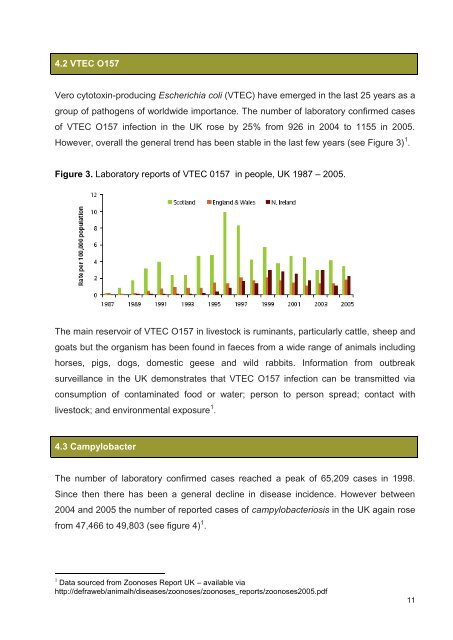Review of the Food-borne Zoonoses Research ... - ARCHIVE: Defra
Review of the Food-borne Zoonoses Research ... - ARCHIVE: Defra
Review of the Food-borne Zoonoses Research ... - ARCHIVE: Defra
You also want an ePaper? Increase the reach of your titles
YUMPU automatically turns print PDFs into web optimized ePapers that Google loves.
4.2 VTEC O157<br />
Vero cytotoxin-producing Escherichia coli (VTEC) have emerged in <strong>the</strong> last 25 years as a<br />
group <strong>of</strong> pathogens <strong>of</strong> worldwide importance. The number <strong>of</strong> laboratory confirmed cases<br />
<strong>of</strong> VTEC O157 infection in <strong>the</strong> UK rose by 25% from 926 in 2004 to 1155 in 2005.<br />
However, overall <strong>the</strong> general trend has been stable in <strong>the</strong> last few years (see Figure 3) 1 .<br />
Figure 3. Laboratory reports <strong>of</strong> VTEC 0157 in people, UK 1987 – 2005.<br />
The main reservoir <strong>of</strong> VTEC O157 in livestock is ruminants, particularly cattle, sheep and<br />
goats but <strong>the</strong> organism has been found in faeces from a wide range <strong>of</strong> animals including<br />
horses, pigs, dogs, domestic geese and wild rabbits. Information from outbreak<br />
surveillance in <strong>the</strong> UK demonstrates that VTEC O157 infection can be transmitted via<br />
consumption <strong>of</strong> contaminated food or water; person to person spread; contact with<br />
livestock; and environmental exposure 1 .<br />
4.3 Campylobacter<br />
The number <strong>of</strong> laboratory confirmed cases reached a peak <strong>of</strong> 65,209 cases in 1998.<br />
Since <strong>the</strong>n <strong>the</strong>re has been a general decline in disease incidence. However between<br />
2004 and 2005 <strong>the</strong> number <strong>of</strong> reported cases <strong>of</strong> campylobacteriosis in <strong>the</strong> UK again rose<br />
from 47,466 to 49,803 (see figure 4) 1 .<br />
1 Data sourced from <strong>Zoonoses</strong> Report UK – available via<br />
http://defraweb/animalh/diseases/zoonoses/zoonoses_reports/zoonoses2005.pdf<br />
11

















